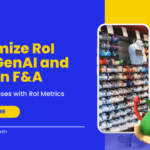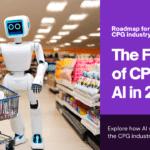In the Consumer Packaged Goods (CPG) industry, where market dynamics shift with breathtaking speed, businesses must navigate a complex web of data to make informed decisions. The solution to this challenge lies in AI-powered Augmented Analytics, an innovation that empowers CPG companies to harness the full potential of their data.
In this article, we embark on a journey through the top 5 AI-powered use cases of Augmented Analytics in CPG. These transformative applications span the entire CPG spectrum, from demand forecasting optimization to customer feedback analysis, presenting a comprehensive overview of how advanced analytics, augmented by AI, is reshaping the industry.
In a world where data reigns supreme, these use cases stand as beacons of efficiency, strategy, and competitive advantage, illustrating the pivotal role AI plays in propelling CPG businesses toward a data-driven future.
1. Augmented Demand Forecasting
Augmented analytics can enhance demand forecasting by automating data preparation, identifying relevant variables, and generating accurate forecasts. AI can assist analysts by suggesting the most appropriate forecasting models, highlighting anomalies in data, and providing real-time updates as new data becomes available. This augmented approach streamlines the forecasting process, reduces human bias, and improves forecast accuracy.
2. Product Development Enhancement
Augmented analytics can support product development by analyzing consumer data, market research, and competitor information. AI algorithms can identify emerging consumer preferences and market gaps, aiding product ideation. Furthermore, augmented analytics can automate the analysis of sensory data, helping CPG companies fine-tune product attributes like taste, texture, and scent based on consumer feedback and sensory analysis.
3. Augmented Marketing Strategy
In marketing, augmented analytics can assist in campaign optimization by automatically identifying key performance indicators (KPIs) and trends in marketing data. It can recommend personalized marketing strategies for different customer segments and provide real-time insights into campaign performance. This augmented approach helps marketers make data-driven decisions and adapt strategies on the fly.
4. Supply Chain Risk Assessment and Mitigation
Augmented analytics can enhance supply chain risk management by continuously monitoring various data sources, including news, weather, and market trends. It can automatically flag potential risks and recommend mitigation strategies based on historical data and real-time information. This augmented approach enables proactive risk management and reduces the impact of disruptions.
5. Augmented Customer Feedback Analysis
Augmented analytics can automate the analysis of customer sentiment and feedback. AI-powered natural language processing (NLP) can classify and prioritize feedback, identify emerging trends, and even suggest action items based on customer comments. This augmented analysis enables CPG companies to respond more effectively to customer concerns and make data-informed product and service improvements.
Incorporating augmented analytics into these use cases empowers CPG companies to make more informed decisions, optimize processes, and stay agile in a rapidly changing market. Augmented analytics leverages AI’s capabilities to assist human analysts in extracting valuable insights from data, thereby improving overall decision-making and competitiveness in the CPG industry.



